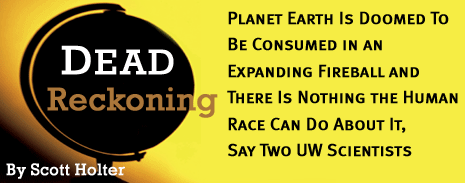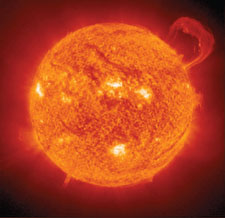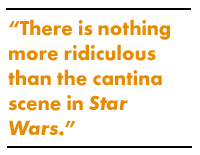
Once we lose the plants and animals, the oceans are not far behind, the latter's downfall leaving the Earth a rust-colored planet like Mars instead of the blue planet seen from space today.
Still, the authors agree that despite the doom that lies ahead, there is no better place or time to be in the solar system than Earth, circa 2003.
"It's likely that life just pops up on an oasis like Earth, then evolves and goes away," says Brownlee. "An analogy would be an island in the Pacific. It forms in the ocean, and it's a terrific place to be for a time. But one day it disappears below the waves, and any life that cannot either fly or float from the island is doomed."
When the sun does reach its Armageddon sometime around high noon, it will have become one hundred times larger and several thousand times brighter than its current state. Mercury and Venus will be first to go, then Earth, leaving Mars the nearest planet to the sun.

The sun sends out a solar flare. Someday it will swallow the Earth. Photo courtesy of NASA.
Earth's fate is an either-or proposition. Either the sun leaves our world a scorched planet orbiting a white dwarf star. Or it swallows the Earth whole, absorbing its atoms and spewing them into space to form new generations of stars and planets.
At 12 billion years, the authors write, "the energy generation rate briefly increases 10 billion times but the brightness of the sun, its energy radiated to space, paradoxically plummets. ... The last and brightest flash may be the one that finally envelops the Earth, causing its complete destruction."
According to Ward, not one human will be left to see it, hear it or feel it. "If plants and animals go away," he says, "we don't have to worry about what we eat, because we won't be there either. The challenge is not to let them go away."
Surely, the relentless and exploratory human race can come up with something to either expand the food chain or halt the end-of-the-world synopsis before it happens: heat shields, oxygen masks, food made of rocks, synthetic drinking water, even an invention that adds hydrogen back into the sun to prolong its life.
"Unless we turn out to be much more capable than I think, there's not a snowball's chance in hell of that happening," Brownlee admits. "More than 400 million tons of hydrogen are used by the sun every second."
 Then, of course, there is space travel. Twenty-first century lore targets Mars as the most Earth-like planet available for human life to exist. Fifty percent farther from the sun than Earth, it also has half the sunlight, thus half the warmth. Think Antarctica without the air, water, energy or minerals.
Then, of course, there is space travel. Twenty-first century lore targets Mars as the most Earth-like planet available for human life to exist. Fifty percent farther from the sun than Earth, it also has half the sunlight, thus half the warmth. Think Antarctica without the air, water, energy or minerals.
But, Brownlee says, in a few billion years when the sun becomes twice as bright, it will leave Mars with the same solar energy per unit area as the Earth does at present. Eventually it will become more than 5,000 times as bright, leaving Mars so hot its surface rocks will melt.
As for living on other planets, Brownlee says television has left a great disconnect of what people believe about Earth and its life. "TV gives the impression that most planets are like Earth and most aliens are fantastically people-like," he says. "There is nothing more ridiculous than the cantina scene in Star Wars (where Luke and Obi Wan Kenobi meet Han Solo and Chewbacca). Even if anyone develops star travel, it will take centuries to go from star to star."
Ward agrees, noting that many who think space may be our savior don't take distances into account. "One of anything doesn't sound like a lot. But one light year? That is a long, long distance.
"Whether humans survive or don't survive, this is going to happen to the Earth. That's science," Ward continues. "What humans might do, that's not science, that's fortune-telling."
Brownlee says he and Ward haven't encountered too many opposing views along the way because most of what they infer is nothing but cold, hard science.
"There's a lot of time between now and the end of the world, and many things can be disproved in time," he says. "Is broccoli good for you or bad for you? That will change back and forth as we learn more about it. But the fact that the sun will burn out in 7.5 billion years? That will never change."
—Scott Holter is a Seattle free-lance writer. This is his third piece for Columns
Go To: Page 1 | Page 2 | Page 3
Sidebar: Seeking Life on Other Worlds
- Return to September 2003 Table of Contents